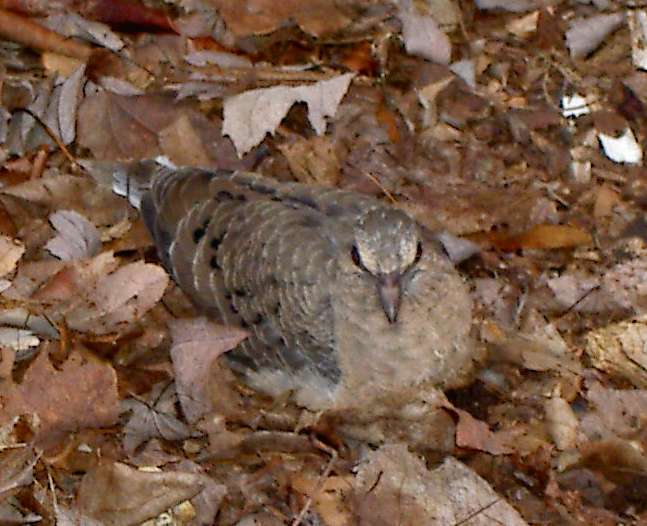I love the beach. Any beach, any weather. I love the pebble beaches of Lake Erie, the quicksand swampy beaches on Cape Cod, the cliff-lined beach in Carlsbad, and the rocky beaches in County Donegal. It is safe to say I haven’t met a shoreline I didn’t like. Hilton Head is no exception, which is no surprise, as everyone loves the beach there. The sand is hard-packed and easy to walk on, the high tidemark is (seeming) miles from the water at low tide, and there are all kinds of sea creatures great and small wherever you turn. Since this wasn’t my first trip to the ocean, I didn’t insist on going in the (still quite cold) water for hours on end; instead we walked the beaches nearly every night and participated in a ritual dunking on the last morning of our trip.
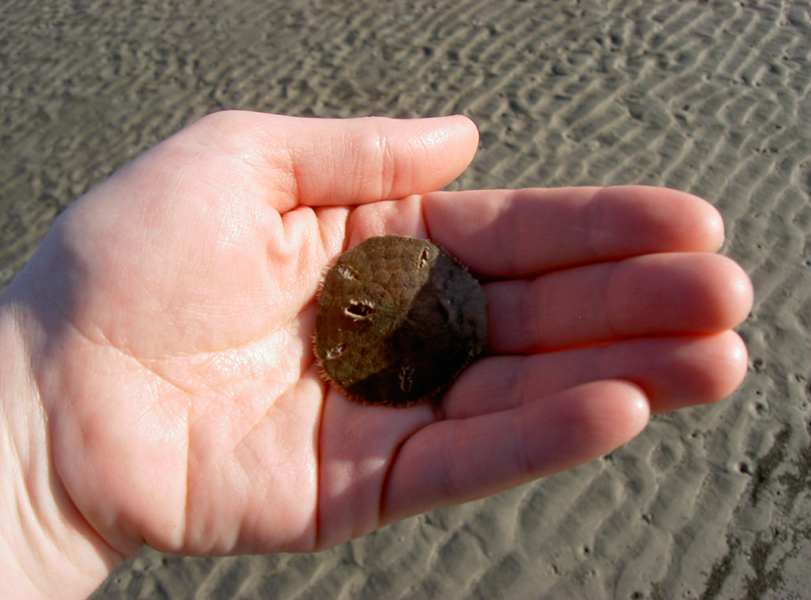
Keyhole urchin.
I had very few goals on this trip, and one of them was to acquire a sand dollar. Acquiring a sand dollar of a consequential size from the beach is harder than I realized, for a few reasons. First, it’s illegal to take them from the beach when they’re still alive. Second, they usually live along the bottom of the ocean. Third, if and when they do wash up onto shore, the gulls peck at them and break them, especially the larger ones (which I imagine are the only ones that have enough food inside to make breaking them worth the trouble). This adds up to lots of pieces of larger sand dollars, which are the skeletons of dead keyhole urchins, and lots of smaller living keyhole urchins washed up on the beach at high tide, and quite a few pecked at and soon-to-be-both-dead-and-broken keyhole urchins, but very few of our target item of suitably-dead-but-neither-broken-nor-tiny sand dollars. In the end, we collected a handful of what could best be described as urchin corpses: urchins that were in a relatively advanced state of decay but had not yet dried to a full sand dollar skeleton. In the end I was glad that I took this approach, as there were hundreds of sand dollars washed up on the beach that night and none any of the other days we were there. We also saw two starfish that night, floppier than the ones in the Northeast and beige-speckled like the crabs we came across; no pictures of either of those, as I was busy trying to throw them back out into the water.
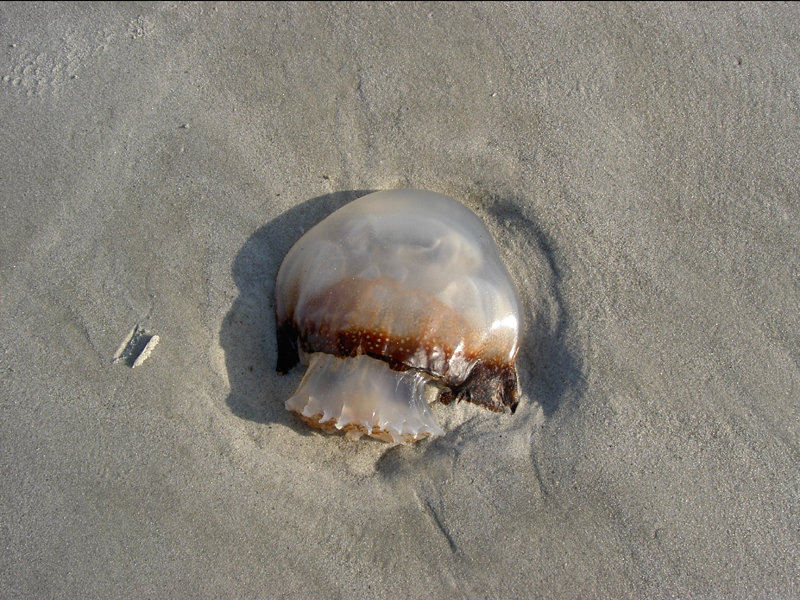
Jellyfish, washed up.
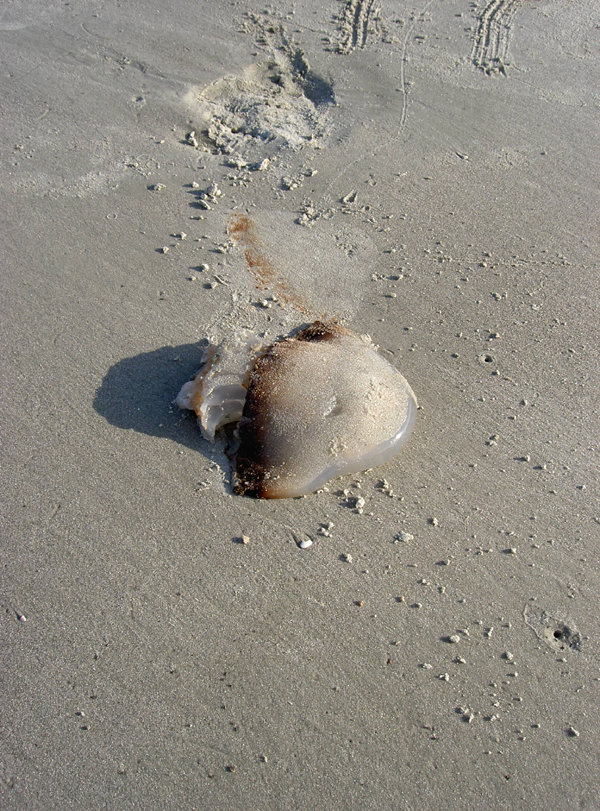
Different jellyfish, washed up and kicked around by children.
I think it’s safe to say that the most disturbing part of our vacation for my partner was the jellyfish. Since Hilton Head is where I first visited the ocean, and my first visit was following relatively major storms, the jellyfish that were washed in with the tides were exactly as I remember jellyfish. Enormous. Which is why I’ve always been trepidatious about them, and have stood in awe of those friends from the Northeast who poo-poo jellyfish and talk about ‘just brushing them aside’ should you happen to encounter them in the water. Apparently, this awe has been totally unearned all these years, because jellyfish in the Northeast are about two inches big. Yes, two inches. No wonder they thought I was a silly land-lubbing Midwesterner for being just the teensy bit afraid of getting stung and not terribly confident in my ability to ‘just brush them aside.’ Because the jellyfish on Hilton Head are quite literally as big as my head, that’s why. Once my partner realized this he pretty much refused to go in the water at all, and most definitely refused to go in the water along the stretch of beach where we were seeing a jellyfish corpse about every 10 feet or so.
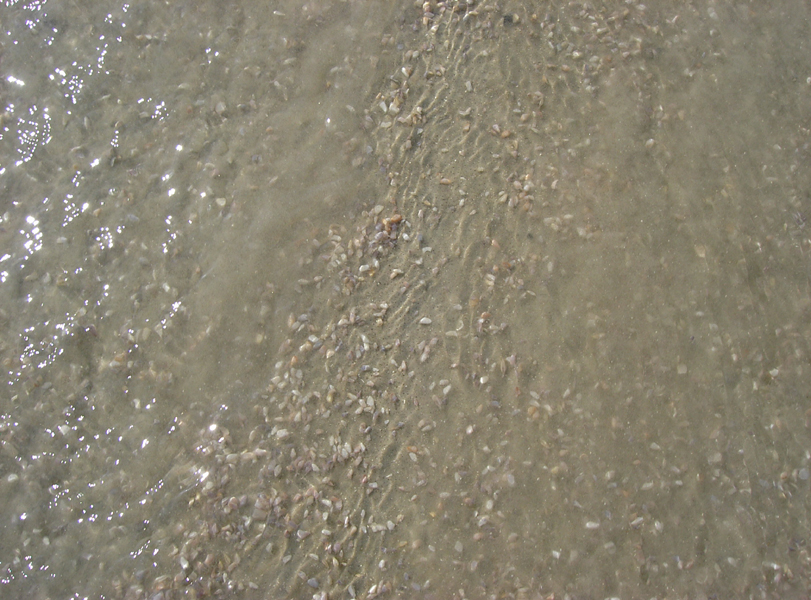
Little clams exposed by the tide.
One of the many creatures on Hilton Head that aren’t on the north Atlantic beaches, as far as I’ve been able to tell, are little tiny multi-colored clams that live on the shoreline with only a thin covering of wet sand. They are exposed in massive numbers by the tide washing in and receding, and then promptly wiggle around and dig themselves back under the sand. Which makes them darn hard to take a picture of. At first I thought they were just getting washed back out, but after digging around with our feet we realized that the sand was laden with them. Also, if you stand on the mass of them you can feel them wiggling their way back under cover; it’s a weird and compelling feeling. You begin to see why I love the beach, I could do things like stand around on pile of little tiny clams for hours and continue to be entertained. Not so much my partner, which is why we have other experiences to report than ‘I went on vacation and stood on clams.’

Jack’s sand castle.
Walking in the evening after the kids have been taken in for dinner and the tide is just coming back in, we came across many abandoned sand castles. This was the best one, for a few reasons. One, it had a functional moat. Two, it incorporated keyhole urchins, which we liberated into the moat after this photo was taken. Three, it clearly stated next to it ‘Jack only, no Mom!’ Which I’m sure was heartbreaking for Jack’s mom, after she brought him to the beach and all; we, of course, found it hilarious.
Because of the late winter this year, there were not yet any Loggerhead turtles coming up onto shore to lay their eggs. We would have been at the very beginning of the nesting season and lucky to have seen one around the first of May during any year, and the folks at the Coastal Discovery Museum relayed that not a single nest had yet been reported by anyone. This was one of the other things I really wanted to see, it just wasn’t meant to be on this trip.
